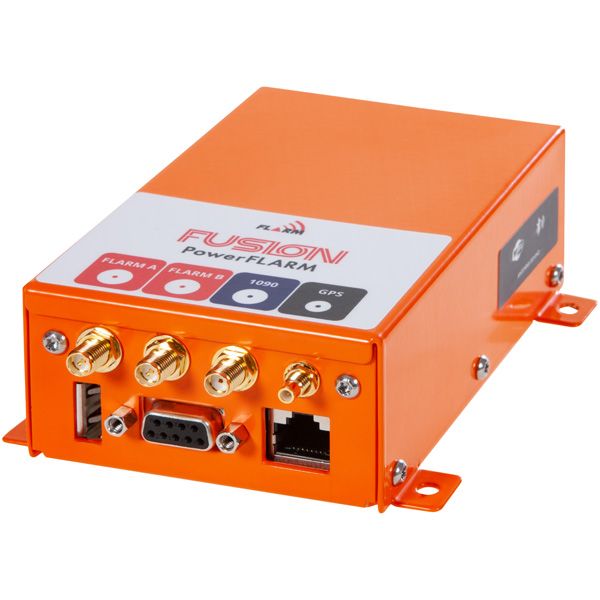PwerFlarm Fusion
Manufacturer Part Number: FLAFUS10W
Creating an account has many benefits:
- See order and shipping status
- Track order history
- Check out faster
FLARM PowerFLARM Fusion
Safety Made Easy


General Description
FLARM PowerFLARM Fusion - combines the robust and proven PowerFLARM technology with the easiest and most comprehensive configuration and maintenance interface on the market. Introducing FLARM Hub — a web app that runs on the device and works with any smartphone, tablet, or desktop computer — configuring your FLARM has just become super easy.
FLARM Hub can be used for firmware and obstacle database updates. IGC files can be downloaded directly to the computer or mobile device. Additionally, FLARM Hub has a traffic display, a bi-directional data port, and built-in tools for range analysis as well as diagnostics & support.
Furthermore, PowerFLARM Fusion has a range of Bluetooth and Wi-Fi connection options and can connect to major navigation apps directly such as Air Navigation Pro, SkyDemon, ForeFlight, EasyVFR, iPilot, and XC Soar. In addition to the standard FLARM data port protocol (ICD), PowerFLARM Fusion also supports the GDL 90 protocol used by many EFBs and navigation apps.
Features
- Next generation PowerFLARM technology, works worldwide
- Wi-Fi and Bluetooth connectivity
- FLARM Hub embedded web app for easy Configuration & Maintenance
- Stream data to ForeFlight, SkyDemon, EasyVFR, and other navigation apps
- Radio diversity and ADS-B/ADS-R/TIS-B & Mode-S receiver (1090 MHz) for complete coverage
- IGC recording (up to diamonds) with ENL
FLARM PowerFLARM Fusion price varies depending on selection above.


| Dimensions | 119 x 80 x 42 mm |
| Mass | 250 g |
| Power supply | 12–32 V DC ±5% |
| Current consumption (no external consumers) |
200 mA @ 12 V DC (Peak) 180 mA @ 12 V DC (Typical) |
| Current consumption (maximum load with external consumers) |
850 mA @ 12 V DC (Peak) |
| Supply for external devices | 250 mA @ 3 V DC (D-sub, RJ45) 700 mA @ 5 V DC (D-sub, USB) 200 mA @ 12 V DC (D-sub, RJ45), 80 mA @ 32 V DC (D-sub, RJ45) |
| Data Ports | D-sub DE-9 and RJ45, RS-232 FLARM ICD @ 4.8–230 kBaud Garmin TIS @ 9.6 kBaud (RS-232) |
| Wireless Data | FLARM ICD: Wi-Fi (TCP, WebSocket) and BluetoothGDL 90: Wi-Fi |
| Audio Out | AC, 1.7 V peak-to-peak @ 1 kΩ |
| GPS | SMC connector External 50 Ω active (4.7 V) antenna Accuracy ≤ 5 m (typical) |
| Radio (FLARM) |
RP-SMA Connectors (2x) 868 to 869 MHz (SRD860 band) 902 to 928 MHz (ISM band) |
| USB | Connector for USB 2.0 sticks FAT16, FAT32, exFAT; 128 GB max. |
| Operating temperature | −15 to 70 °C |
| Detection range | >10 km (typical) Depending on antenna and installation |
| Accessories (Included) |
Internal FLARM antennas (2 pcs.) Internal 1090 ADS-B/SSR antenna Internal GPS antenna Data cable with D-Sub DE-9 connector at one end USB extension cable for panel mounting; socket with protection cap |
| Accessories (Optional) |
Adapter kit for upgrade from PowerFLARM Core AV-75 external FLARM antenna |
| Circuit Breaker | 3 AMP |


- PowerFLARM Fusion
- Internal FLARM antennas (2 pcs.)
- Internal 1090 ADS-B/SSR antenna
- Internal GPS antenna
- Data cable with D-Sub DE-9 connector at one end USB extension cable for panel mounting; socket with protection cap
Is FLARM certified?
Yes, FLARM is approved by EASA for installation is certified aircraft. In light airplanes, FLARM can be installed either as a Standard Change (CS-SC051b) or as an EASA approved Minor Change (MCA) based on an Approved Model List (AML). The difference is that the Standard Change is limited to VFR day. The Minor Change does not have such limitations. Both options require an approved AFM Supplement.
What does "Error Code 41: FLARM radio" mean?
In rare circumstances, sensitive RF components can get damaged. Such a defect causes (illegal) spurious emissions of the device in licensed frequency bands, such as mobile phone bands. Such devices must be repaired.
After turning on the device, the PowerFLARM firmware automatically detects this condition. This is shown as Error 41. In the log file, typically lines as shown below appear.
WARN RF Radio A appears to be damaged
ERROR PFAPP *** Initialization failed: FLARM radio
At the end of the log file, the following error message is emitted once per second for 30 seconds.
INFO PFAPP Error: Severity = 2, code = 41: FLARM radio
If this error appears, the device must be repaired. Please see https://support.flarm.com/hc/en-us/articles/360018800273-How-do-I-get-my-device-repaired- on how to proceed.
Always make sure to check your installation (see FTD-041).
Affected devices: PowerFLARM Core and PowerFLARM Core Pure
Introduced: PowerFLARM firmware 7.06
Can I use PowerFLARM Fusion or Portable in an aircraft with pressurized cabin?
PowerFLARM devices contain a pressure sensor (see also What is the pressure sensor used for?), which obviously won't produce correct readings in a pressurized cabin. PowerFLARM can still be used in these aircraft with the following provisions:
Either
1090 processing is deactivated, or
the aircraft is equipped with a Mode-S transponder. In this case, PowerFLARM will use the pressure altitude from the Mode-S signal. This is enabled by default (see below). Make sure the transponder type and aircraft address are configured correctly.
The pressure altitude recorded in the IGC file will not be correct. The IGC file still contains the correct GNSS (geometric) altitude, so this is not an issue in most cases.
What is the difference between e.g. FLAPFC10E and FLAPFC11E devices?
The digits in the part number specify the hardware version of the device.
PowerFLARM Core devices with the digits 10 imply hardware version 1.0 and do not have the option for audio out. Digits 11 imply hardware version 1.1 and have the option for audio out.
PowerFLARM Portable devices currently have digits 23 and 24. Hardware version 2.4 is an updated version with improved out-of-band filtering.
The character 'C' in e.g. FLAPFC11E (PowerFLARM Core) or 'P' in e.g. FLAPFP24E (PowerFLARM Portable) indicates that the device has a 1090 MHz receiver (SSR and ADS-B).
The last character (e.g. 'E' in FLAPFC11E) indicates the radio band version of the device.
What is the pressure sensor used for?
The pressure sensor is used only for SSR traffic (Mode-A/C/S) and ADS-B, unless you have a Mode-S transponder, in which case it will use your Mode-S reported altitude instead. The pressure is used to compare the own altitude with the reported altitudes of other transponder and ADS-B aircraft. The pressure is also used to log the altitude in the IGC file (used by gliders). The pressure sensor can be calibrated using a calibration center, which will results in a calibration report. No calibration values are programmed in the device.
For collision avoidance with other FLARM equipped aircraft, FLARM uses only the more accurate GPS altitude difference.
















